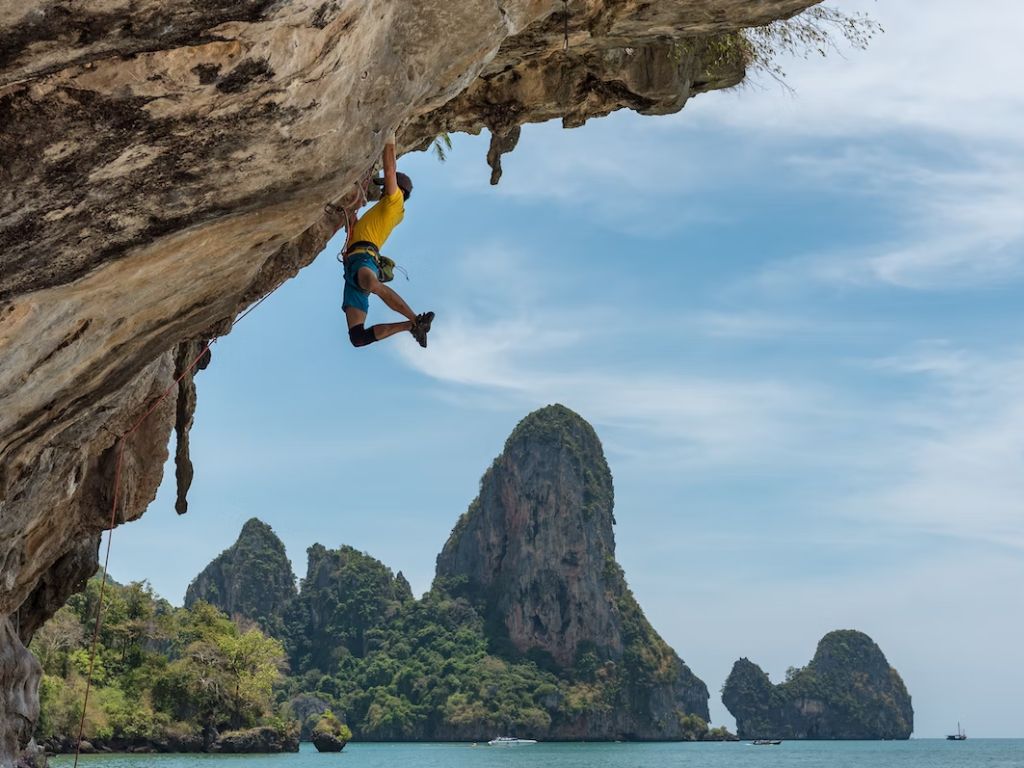I have been rock climbing and bouldering for over 2 decades. It’s THE THING that got me into outdoor/extreme sports. Lucky for me, we have many unique spots here in the United States.
To tell you the truth, it’s nigh impossible to objectively settle on a dozen spots on Earth that are best for climbing. There are so many places that some of you will instantly fall in love with.
However, it’s also true that rock climbing is one of those adventure sports where the location plays a key role. It’s much more than clambering up a rocky cliff, after all.
So, after a great deal of research and effort, I settled on these 13 spots for “the best rock climbing locations worldwide.” What makes them the best, you ask?
I figured that an ideal rock climbing location on a global scale must have four things:
- comfortable climate,
- affordable accommodations,
- vacation spots for other activities, and
- accessible healthcare.
If you’re in a hurry…
The U.S. has the best cliffs and tracks for rock climbing in the world for bouldering, speed, trad, and sports climbing. Yosemite National Park and Devil’s Lake are the two prime destinations in the USA where climbers flock in from all over the world.
1. Devil’s Lake, USA
| Total Routes | 2790 routes |
| Popular Climbs | Peter’s project (5.7), Upper diagonal (5.9), The flatiron (V4) |
| Rock Type | Quartzite |
| Difficulty | 5.5-5.12 |
| Best season for rock climbing | Spring (March) to late fall (December) |
| More to explore | Swimming, Hiking, Kayaking, Birdwatching, Biking, Fishing, Skiing |
| Cost of accommodation | $68 onwards |
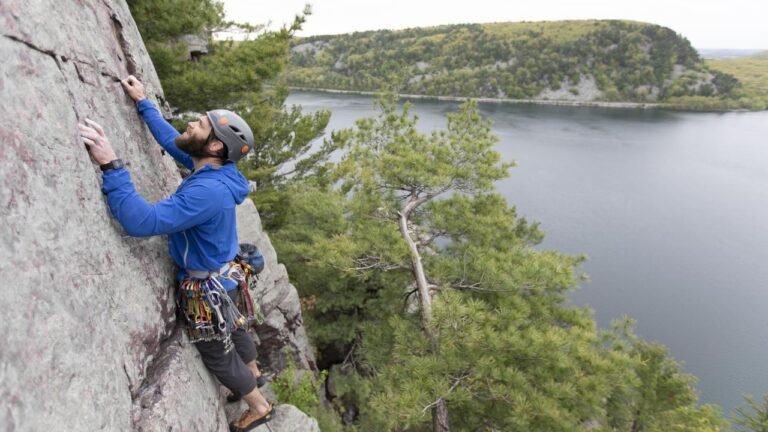
Getting its name from the Sioux natives and their legends, Devil’s Lake is one of my favorites for rock climbing and bouldering. It’s filled with tourists from around the globe during vacation seasons, thanks to the hiking and biking trails.
Devil’s Lake is a rock climbers’ haven, home to many routes, most of which are of moderate (5.5-5.8) difficulty. Veteran climber John Gill himself has set foot here – there’s even a rumor about this in the flatiron climbing route. This location is best suited for traditional climbing.
Pros
- Great for bouldering. It has some of the world’s most popular bouldering problems.
- It offers many alternate activities – you can go on hikes and set up camps or get your fishing rod a little warmup.
Cons
- It’s crowded all year round.
- Most ratings are from times when 5.10 was the max difficulty, leading to inaccuracies.
For non-US residents, North Dakota is where you become one with nature. It’s hard to get bored here. Start your day with a walk along the trails and end it with a trip to the North Dakota heritage center.
2. Squamish, Canada
| Total Routes | 1886 routes |
| Popular Climbs | Klahanie Crack (5.7), Penny Lane (5.9), Gollum’s impromptu sacrifice (5.8) |
| Rock Type | Granite |
| Difficulty | 5.4-5.14 |
| Best season for rock climbing | The dry season (mid-May to August) |
| More to explore | Van Life, Hiking, Slacklining |
| Cost of accommodation | $50 onwards |
| Flights from the US (one-way) | $150 – $300 |
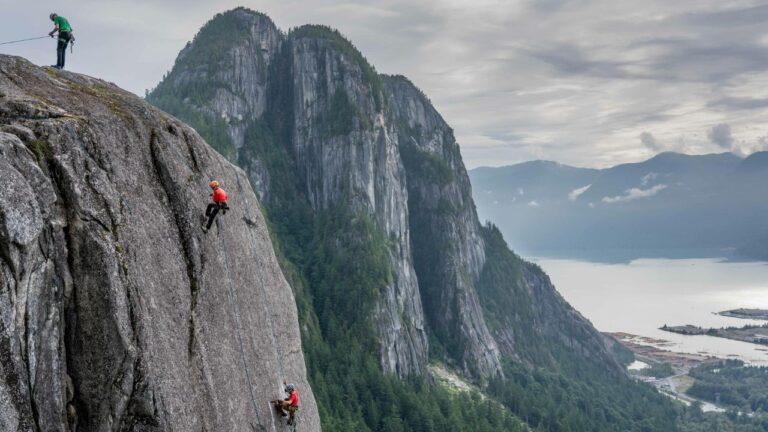
Squamish has numerous bluffs and some of the most beautiful rock climbing routes. Modest elevation and multiple multi-pitched routes make it ideal for traditional climbing and bouldering.
Pros
- Suitable for climbers of all skill levels.
- Quite convenient due to its proximity to Vancouver.
- Lots of activities apart from climbing.
Cons
- The area is prone to rainfall.
- High humidity results in slippery rocks.
- Lack of town culture and liveliness.
Stawamus Chief – The Grand Wall
Climbing in Squamish is often synonymous with “The Chief.” This west-facing giant is the key attraction among climbers and hikers alike.
I was in awe when I first set foot on the marvelous monolith called Stawamus Chief. The flat face is a rough challenge and no less rewarding. There is something for almost everybody! Climbs here lie in a grade range of 5.8 to 5.13.
Being the single most visited climb in Squamish, it’s unsurprising that the routes in Stawamus Chief are HUGE. Exploring some of these might take days, but no one’s complaining. Bivvying is bliss anyway.
The Grand Wall, in particular, is a fan-favorite. There are several ways to get here. One includes climbing the Apron Strings, yet another popular climb graded 5.10b guides you to The Grand Wall.
Conquering Stawamus Chief will need some planning. Make a checklist, and plan your trip early because the sun is hot here once it’s past noon.
What else can you do here?
As for your nighttime, “van life” is pretty popular in Squamish. Just know better than to litter around or van camp near the municipality of Squamish.
Town culture in Squamish isn’t particularly unique in any way. Still, if you’re rock climbing to Squamish, you’ll find many like-minded people to hang out with.
Squamish is popular for many sports like hiking, kayaking, yada yada yada. But more importantly, if you like sushi as much as I do, you gotta visit the Kozo Japanese Cafe.
3. Ha Long Bay and Cat Ba Island, Vietnam
| Total Routes | 11+141 routes |
| Popular Climbs | Luy Tam Biet, Streak of Lightning |
| Rock Type | Limestone |
| Difficulty | 5.5-5.13 |
| Best season for rock climbing | Summertime (May to July) |
| More to explore | Deep Water Soloing, Hiking, kayaking |
| Cost of accommodation | $15 onwards |
| Flights from the US | $1,000 – $2,000 |
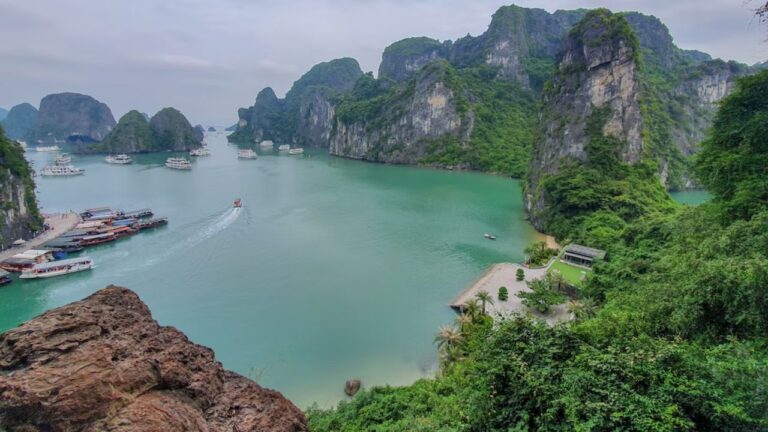
These are two closely located places on the Cat Ba archipelago. Ha Long Bay and Cat Ba Island not only host some of the best deep water soloing locations worldwide but the former is also an UNESCO heritage site.
Deep water soloing is the ultimate thrill, the scariest among all variations of rock climbing. Cat Ba is known for deep water soloing in the Hidden Valley area. With large hanging cliffs and ocean underneath, this is the perfect spot to let go of your safety equipment and let the water protect you.
Pros
- World-class deep water soloing
- Abundance of cultural heritage to immerse yourself in fresh seafood and age-old festivals.
Cons
- Slippery rocks due to high moisture.
- Lack of transport facilities
Getting to Cat Ba requires changing buses a few times from Hai Phong and a 30-minute Hydrofoil boat journey. Apart from that, transport within the island is scarce.
The Vietnamese Climate
The climate here is warm most of the year. Rains might be the only thing holding you back in Vietnam. April to July and September to December are considered ideal for rock climbing. The winter sets in after December, making it harder to climb.
4. Yosemite National Park, USA
| Total Routes | 2601 routes |
| Popular Climbs | The Nose (5.9), Separate Reality (5.12a), Freerider (5.13a) |
| Rock Type | Granitic |
| Difficulty | 5.6-5.13 |
| Best season for rock climbing | Late Spring (May) to early fall (Mid-September) |
| More to explore | Birdwatching, Hiking, Stargazing, Fishing, Horseback riding |
| Cost of accommodation | $100 onwards |

Characterized by waterfalls, sequoias, and the Sierra Nevada red fox, California’s Yosemite National Park marks the origin of rock climbing in America. The Mirror Lake and Yosemite Falls trails are popular hiking attractions.
The YNP is a major tourist spot, bustling throughout the year. Among the world-famous spots, there are a few I admire deeply: The Nose (31 pitches, 5.9), Separate Reality (5.12a), and Freerider (30 pitches, 5.13a).
10 of the 30 pitches in the Freerider route can be independently explored as a much easier set of climbs called the “Freeblast.” While it’s considered best for traditional climbing, sport climbing and bouldering are equally possible in Yosemite National Park.
Pros
- Moderate temperatures year-round.
- Versatile climbing challenges for every type of climber.
Cons
- Yosemite can get very crowded during peak season.
- The remote and difficult climbing routes require some hiking to access.
The Iconic Half Dome
Located in the heart of Yosemite Valley, the Half Dome is one of the most sought-after climbing locations at 8,842 feet tall. The hike up is a strenuous 8.5-mile round-trip, and the climb is a serious undertaking.
Routes ranging from 5.9 to 5.13 in difficulty are the way up, but the most popular route is the Regular Northwest Face Route. This route is graded 5.9 and mostly requires trad climbing gear. The first pitch may prove difficult, but the rest is mostly scrambling.
Although the views from the top of the Dome are breathtaking, I promise you that the journey will be worth it even if you don’t reach the top.
5. Cerro Ventana Sur, Argentina
| Total Routes | 45 routes |
| Popular Climbs | Lo Spirito dei Montani (7 pitches, 5.9), Brambillandia(5.10), Piña Colada (5.6) |
| Rock Type | Andesite |
| Difficulty | 5.6-5.11 |
| Best season for rock climbing | Early December to April |
| More to explore | Hiking, biking and camping in Los Coihues. |
| Cost of accommodation | $59 onwards |
| Flights from the US | $400 – $800 |
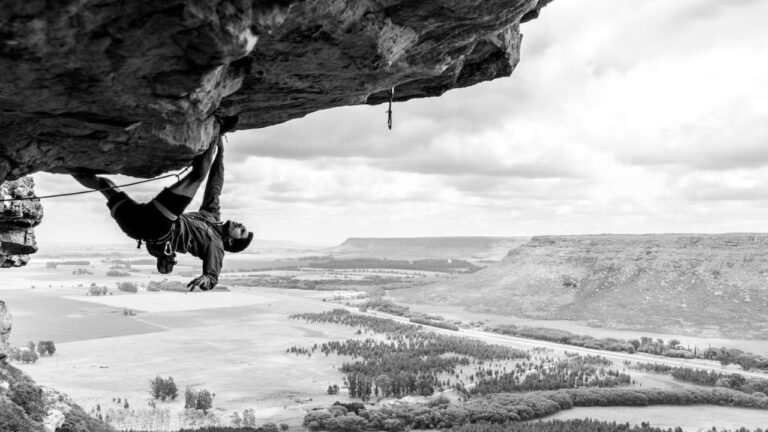
Cerro Ventana Sur’s rock climbing routes are famous among sports climbing enthusiasts. This place also has much less traffic so you can experience some peaceful time away from the crowd, in the mountains.
As the name suggests, it’s located to the sur (south for Spanish) of Ventana, known for warm weather and plenty of climbing routes.
The population is scarce here, but there is plenty of vegetation. You get to live with nature in its true form. Make sure to carry your essentials. The weather here is warm throughout the year, so you don’t have to worry about timing your visits.
Pros
- Warm, comfortable weather all year long.
- You can plan a visit to this place any time of the year.
Cons
- It’s notorious for loose rock formations; you must stay vigilant.
6. Gorges du Verdon, France
| Total Routes | 45 routes |
| Popular Climbs | Chlorochose (7 pitches, 5.8+), Afin Que Nul Ne Meure (5 pitches, 5.10a), L’ame Fatale (8 pitches, 5.11b) |
| Rock Type | Coral Limestone |
| Difficulty | 5.8-5.12 |
| Best season for rock climbing | Summer (June through August) |
| More to explore | Kayaking, Bungee Jumping, and paragliding. |
| Cost of accommodation | $60 onwards |
| Flights from the US | $400 – $1,500 |
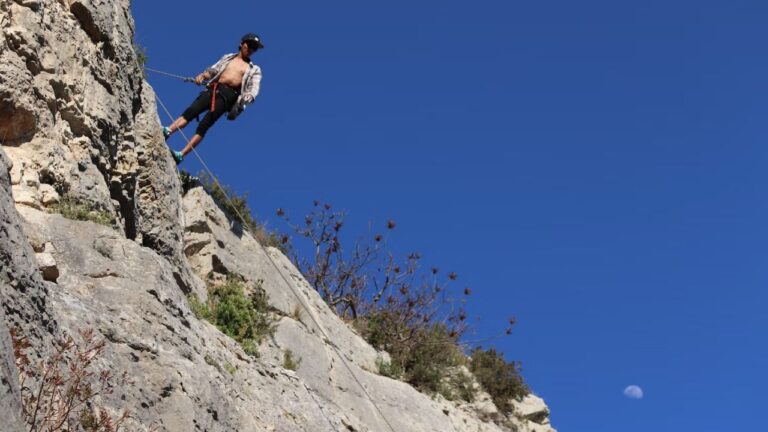
In the motherland of the Fontainebleau, you have one of the most iconic gorges in Europe. Diverse and full of life, Gorge du Verdon is famous for its hiking trails, villages, and beaches.
Gorges du Verdon (Verdon Gorge) has some of the best multi-pitch routes. The climbs here are diverse. Some are populated, while others are isolated. They all have a difficulty rating of 5.8+ and are fit for sport and traditional rock climbing.
Kayaking, Bungee Jumping, and paragliding are popular sports in the Verdon Gorge. You’re never gonna run out of places to tour in France. Saint-Tropez and Porquerolles Islands are close by, in the south of France.
Pros
- Multi-pitch climbing is primarily what Verdon Gorge is known for.
Cons
- Bolts are placed too far apart
7. Railay West, Thailand
| Total Routes | 45 routes |
| Popular Climbs | 20 Kilos of Steel (5.4), Orange Juice (5.12c), The King (5.10d), Fit To Be Thai’d (5.10a) |
| Rock Type | Karst Limestone |
| Difficulty | 5.4-5.12 |
| Best season for rock climbing | Early December to April |
| More to explore | Hiking, island hopping, Kayaking, Hiking and scuba diving |
| Cost of accommodation | $10 onwards |
| Flights from the US | $600 – $1000 |
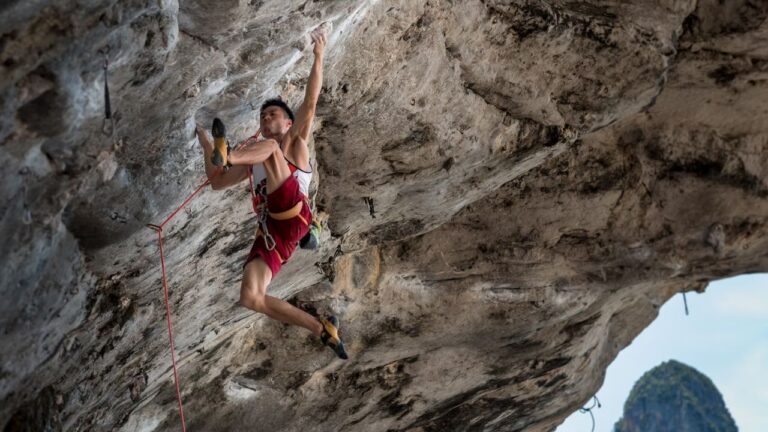
If it’s your first visit to Thailand, prepare yourself for the unequivocal grandeur of the premium resorts in the Railay Peninsula and the iconic Thai longtail boats that get you there.
Railay West is the place where luxury meets adventure. You can experience the wildest rock climbing here, from a modest 5.4 at to a magnificent 5.12c.
Pros:
- World-class craigs for deep water soloing.
- Soothing sunsets, blue skies, and beautiful beaches, there is much more to Railay than just climbing.
- Climbers of all levels of expertise flock here, thanks to its popularity and variety of climb grades. You’re likely to find great climbing partners here.
Cons:
- The sun is scorching
- Railay has a tropical and humid climate.
- The rocks are relatively smooth but need a good grip to climb.
The best of Thailand
The prettiest beaches, the Tonsai Bay resort, beautiful sunsets, and a lively crowd add much to the trip. It’s your turn to experience some of the best Thailand offers!
Rock climbing is one of many activities in Railay West. You can go hiking, island hopping, or simply sit back and relax at the beach. If you’re lucky enough, you might come across bioluminescent planktons that glow with a blueish sparkle at night and the ocean lights up.
Ton Sai
Railay is one of the more touristy beaches out there in Thailand, and the all-year-round influx of tourists keeps the prices stoked up. If you’re looking for a place nearby and aren’t eager to break the bank, Ton Sai is the one for you.
Ton Sai is the affordable version of Railay, with even more climbing opportunities. It has a lot to offer if you’re not looking for premium resorts and will do just fine with the local food.
It’s a 15-minute walk from Railay beach, and you’re likely to find hardcore climbers here who choose adventure over luxury. The difficulty of the climbs is on par with Railay, and the rocks are more or less the same, although certain climbs tend to be way too polished.
8. Kalymnos, Greece
| Total Routes | 1221 routes |
| Popular Climbs | Carpe Diem (5.10c), Taz (5.11a), Feta (5.11a) |
| Rock Type | Limestone |
| Difficulty | 5.7-5.14d |
| Best season for rock climbing | Early December to April |
| More to explore | Hiking, mountain biking and scuba diving |
| Cost of accommodation | $40 onwards |
| Flights from the US | $300 – $1,000 |
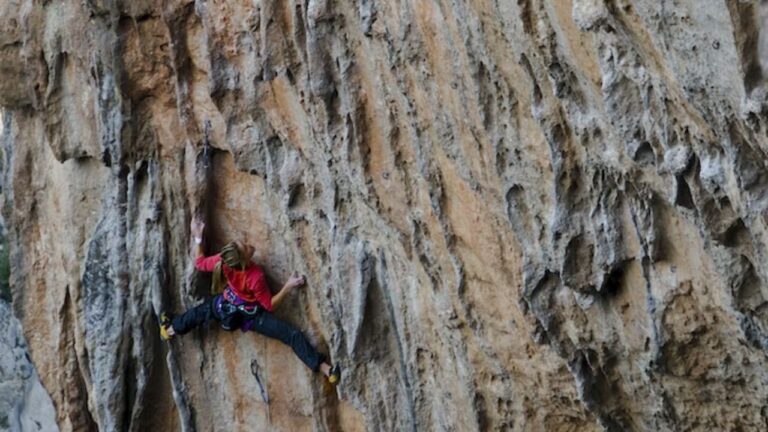
Kalmynos lies between the thriving islands of Kos and Leros. The topography here is widely varied and favors rock climbers and hikers alike.
The limestone cliffs offer some of the best climbing in the Mediterranean, with steep faces and challenging overhangs.
Pros
- Delicious local food.
- Gorgeous views of the Mediterranean Sea.
Cons
- Summer months can be dangerously hot for climbing.
- Bolt positions are difficult to clean.
The Grande Grotta Climb
A popular 8-pitch climb that takes you through large, natural grottos and up a series of large walls. The Grande Grotta climb is a must-do for any experienced climber looking for a challenge. This route is best done in the early morning or late evening to avoid the intense sun during the day.
The climb begins with a moderate 5.7 section and transitions quickly into a 5.10 crux. As you climb, you’ll be greeted by stunning views of some of the iconic rock formations of the island.
And you can not miss the Caves of the Seven Virgins! These beautiful caves are easily accessible by boats near the port of Pothia, in the island’s northern part. Stay away from the bats and birds of the Caves, and you’ll be good!
9. Todra Gorge, Morocco
| Total Routes | 458 routes |
| Popular Climbs | La Marche Verte (5.9+), Une arête dans la Gorge (5.9+), Abert (5.10b/c), Chinania (5.10+) |
| Rock Type | Granite and Limestone |
| Difficulty | 5.5-5.13b |
| Best season for rock climbing | Any time of the year, Autumn is a plus. |
| More to explore | Hiking, mountain biking and scuba diving |
| Cost of accommodation | $25 onwards |
| Flights from the US | $400 – $2,000 |
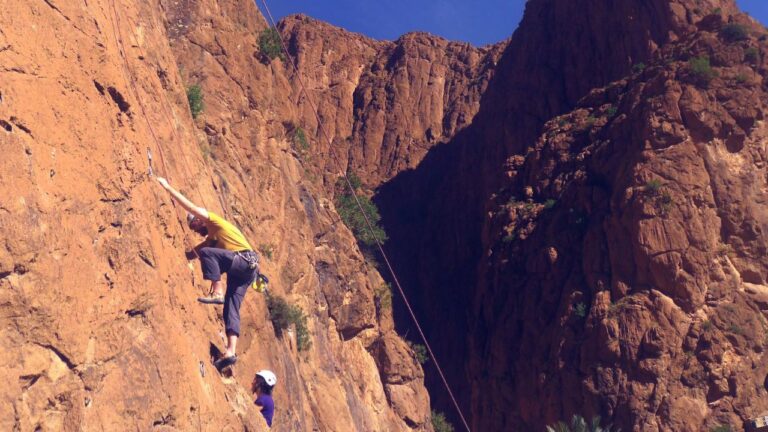
Todra Georgie is in the East of the Atlas mountains, not far away from the dunes of the Draa Valley. The area is mostly empty of vegetation and population, except for a few restaurants and tribes here and there.
The cliffs in Todra Gorge go as high as 900 feet, while the corridor can be as narrow as 40 feet. The whole place is full of rocks and 400+ climbing routes.
Pros
- Moderate and consistent temperatures all year round.
- The area receives little rain, so a downpour won’t ruin your plans.
- Rich in culture and fauna for the explorer in you.
Cons
- The location is remote and difficult to access.
- Limited variety of routes available.
The Great Wall of Todra
Perfect for those seeking adventure, the Great Wall of Todra offers some of the most challenging and diverse routes. This majestic wall is over 200 meters high and is made of limestone, sandstone, and conglomerate.
The granite and limestone cliffs are dotted with terraces and caves, and the views of the surrounding mountains are breathtaking. A great spot for taking photographs and spotting wildlife.
The Todra Gorge is also home to several Berber villages, some of which have existed in the area for centuries. The inhabitants of these villages are known for their unique culture, which is a blend of traditional Berber and Moroccan influences.
10. Mount Arapiles, Australia
| Total Routes | 188 routes |
| Popular Climbs | Tiptoe Ridge (5.3), Have a nice flight (5.12a), Muldoon (5.7) |
| Rock Type | Sandstone |
| Difficulty | 5.3-5.12a |
| Best season for rock climbing | Spring (September-October) and Autumn (March-April) |
| More to explore | Birdwatching, Golf, Hiking |
| Cost of accommodation | $59 onwards |
| Flights from the US | $900 – $1,500 |
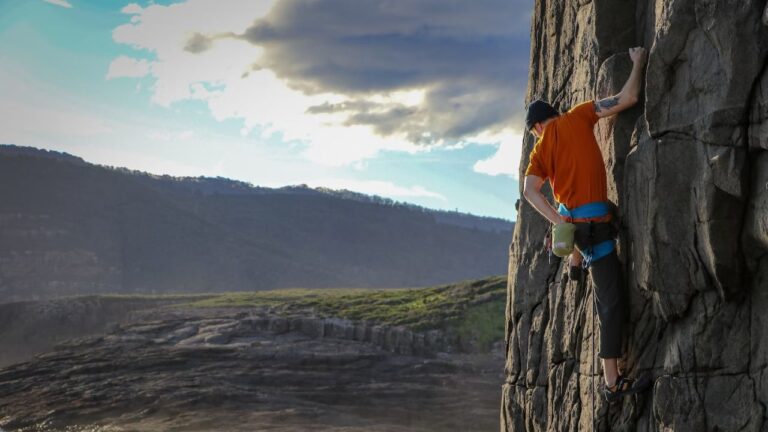
The land Down Under! God, I love Australia.
Mount Arapiles has historically been Australia’s best rock climbing site, housing climbing routes for beginners, intermediates, and experts.
Closeby to the East is the town of Natimuk, with its own delights. Lake Natimuk, The Nati Pub, and Natimuk Golf Course are great attractions here.
Pros
- The Wimmera Sandstone provides excellent friction and grip.
- Variety of different climbing styles suitable for every climber.
- The location is easily accessible and conveniently close to Natimuk.
Cons
- Only designated spots can be climbed as The Arapiles are mostly protected by legislation.
- The area is metamorphosed, so you’ll often find polished rocks.
The Dramatic TipToe Ridge
Located in the Grampians National Park in Victoria, Australia, the TipToe ridge is one of the most popular climbing spots in the Grampians. It’s made of a series of steep slabs of rocks ranging in height from 6 to 15 meters.
The ridge is a popular destination for climbers of all abilities. It offers a variety of routes for experienced climbers and beginners. Popular with birdwatchers, you can spot various birds here, including lyrebirds and wedge-tailed eagles.
Australia is flatland, so don’t expect crazy high cliffs here. Again, since we’re talking of Australia, expect Kangaroos!
11. Chulilla, Spain
| Total Routes | 145 routes |
| Popular Climbs | Long Dong Jhon (5.10c/d), Cantina Marina (5.11c), Smigol (5.11b) |
| Rock Type | Limestone |
| Difficulty | 5.9-5.12d |
| Best season for rock climbing | June through August |
| More to explore | Hanging Bridges, Swimming in Turia, Hiking |
| Cost of accommodation | $59 onwards |
| Flights from the US | $300 – $800 |
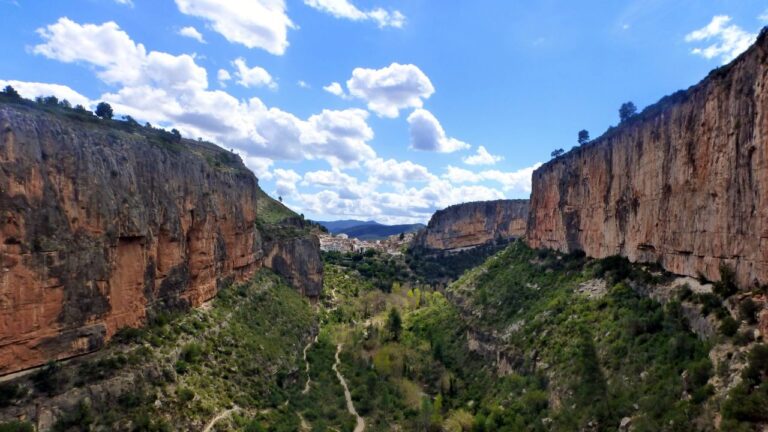
Known for its abundant natural beauty, lush vegetation, and small villages, this area has breathtaking mountains and Mediterranean Sea views.
Chulila has Europe’s most challenging and beautiful climbing routes. This place offers climbers various routes, from craggy limestone cliffs to steep overhangs. The rock is also incredibly solid, perfect for traditional and sports climbing.
Chulila has some of the best climbing hostels you’ll ever stay at. El Altico and La Casa Serena are the best-rated climbing hostels here. These are both very quiet and calm places and offer amazing views.
I know I have mentioned this already, but I’d just go for the views alone!
Pros
- The climbing location is easily accessible.
- Tons of accommodation options, from budget-friendly hotels to luxury resorts.
- Perfect, solid rock for climbing.
Cons
- Full of difficult routes, ideal for climbers who can ace 7a+ routes.
- The place is yet to get proper internet connectivity.
12. Joshua Tree National Park, USA
| Total Routes | 6815 routes |
| Popular Climbs | Bird of Fire (5.10a), Illusion Dweller (5.10b), Leave it to the Beaver (5.12a) |
| Rock Type | Monzogranite |
| Difficulty | 5.4-5.12c, V0-V7 |
| Best season for rock climbing | April through June |
| More to explore | Camping, Hiking, Horseriding, Birdwatching |
| Cost of accommodation | $49 onwards |
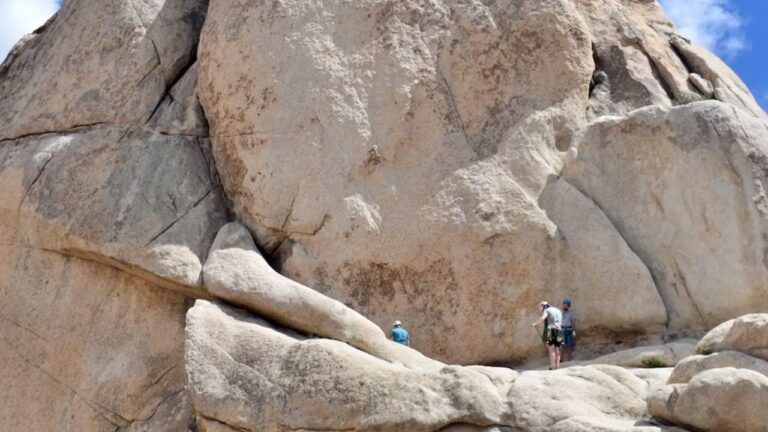
Another one from the US, Joshua Tree National Park, is famous for its numerous routes and serene views of nature. The land has all the necessary amenities located at a safe distance.
Joshua Tree National Park is now gaining popularity as a rock climbing location after long years of being a winter destination for travelers. The rock here is monzogranite, which is pretty solid. The rock is great for climbing, except for some newer routes.
“The Bird of Fire” has to be the most liked 5.10a route at the Joshua Tree National Park. About 10+ initial feet might be scary for the first timers, but the part ahead is an easy climb and dotted with rests. Be sure to check this out if you’re a 10a lover.
Pros
- You’ll always have a new route to climb.
- Offers 24/7 Crash pad rentals.
- All necessary services and supplies are close by.
Cons
- There’s water scarcity inside the park.
- Campsites get sold out months in advance.
13. Frankenjura, Germany
| Total Routes | 1436 routes |
| Popular Climbs | New Dimensions (5.12b/c), Blutspur (5.11c), Devil’s Crack (5.10c) |
| Rock Type | Limestone |
| Difficulty | 5.8-5.13a |
| Best season for rock climbing | Early April to Mid-October |
| More to explore | Hanging Bridges, Swimming in Turia, Hiking |
| Cost of accommodation | $105 onwards |
| Flights from the US | $300 – $800 |
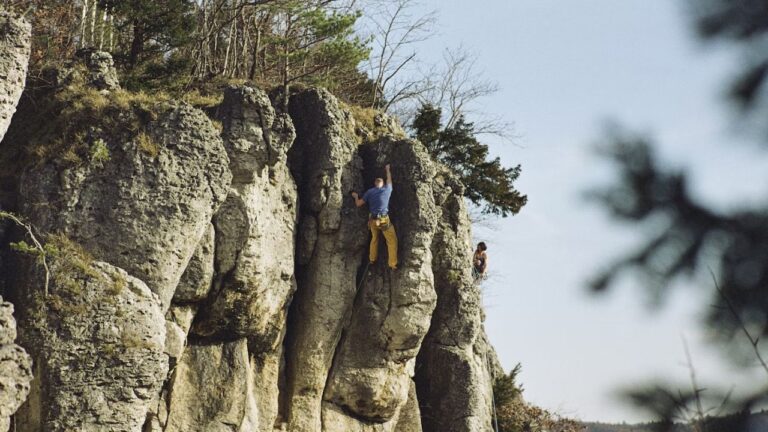
An excellent spot for taking in the beauty of Germany, Frankenjura is home to plenty of hiking and cycling opportunities. As for climbing, this place has been an attraction for climbers ever since the 70s.
It’s located in the Franconia region of Germany and has over 8500 routes. Primarily made of limestone, the rock is apt for climbing. Climbers come together for several climbing festivals that take place here every year.
Frankenjura has its climbing locations divided into three zones. Climbing is prohibited in zone 1 but is allowed in zone 2 if you stay on the existing routes. As for zone 3, you can even establish new routes. Take care of the signs posted wherever you visit for climbing.
Pros
- Large area is full of crags and numerous routes.
- Beer gardens and great food.
- Plenty of lodging options, from hotels to luxury resorts.
Cons
- Lots of Mosquitoes and ticks, especially during the rainy season.
- Lackluster food options for vegetarians.
- Polished rock in some routes.
Expert QnA
Q. Is rock climbing safe?
Safety in rock climbing depends on your gear, discipline, and natural factors. The fatality rate is around 1 in 12000 per year. Rock climbing is safe, given you’ve taken all the necessary precautions.
Natural factors, while accounting for most mishaps, are still quite rare. Rock climbing is safer than driving!
Q. How does the rock climbing grading system work?
The Yosemite Decimal System (YDS) is the most widely used grading system for rock climbing in the US. A 5.0 to 5.7 grade is easy. In contrast, 5.8 to 5.10 are intermediate, and 5.11 to 5.12 are the harder ones, with 5.13 and above being the pinnacle of difficulty in rock climbing.
The digit 5 denotes the class here. 5 is for rock climbing and bouldering, while 1 and 2 are for walking and hiking. The V-Scale is often used for bouldering, while other forms of climbing stick to the YDS.
Q. What weather is optimal for rock climbing?
Autumn is the preferable weather for rock climbing. Rainy weather is especially unsuitable for climbing and bouldering as it directly affects your grip. Summer is also a good time to climb, but make sure the temperature is below 70 degrees to avoid excessive sweating.
Q. What rock type is the best for rock climbing?
Limestone is the sturdiest of rocks and is deemed the best for rock climbing as a beginner. It has finer elements, is not prone to erosion, and provides a much better grip. If you’re willing to take on traditional rock climbing, Granite is your best friend.

